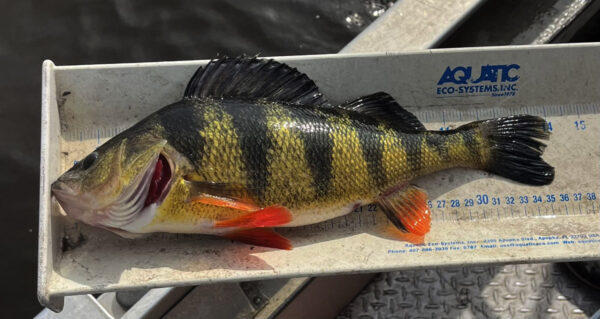Virginia DWR Aquatic Education Coordinator, Alex McCrickard, shows off a Yellow Perch.
A Yellow Perch being released. ©Photo by Alex McCrickard
Fact File
Scientific Name: Perca flavescens
Classification: Fish, Order Perciformes, Family Percidae
Size: Yellow Perch in Virginia average 6 to 8 inches, but some specimens can surpass 15 inches in length.
Life Span: Yellow Perch in Virginia can live for about 12 years.
Identifying Characteristics
- Dark olive to black on the back, transitioning to golden yellow along the side
- Dark colored vertical bars along its side
- Colloquially referred to as Ring Perch throughout much of the Chesapeake Bay
- Ventral (lower body) fins are yellow to orange, peaking in color during the breeding season
- Dusky blotch at the base of the spiny dorsal fin
Habitat
Yellow Perch often school near hard structures or submerged aquatic vegetation in moderately deep waters. Yellow Perch prefer gravel and sand substrates, where their food sources are more abundant.
Diet
Yellow Perch feed heavily upon zooplankton and aquatic macroinvertebrates as juveniles. Their diet shifts heavily to fish, as well as small crustaceans as they mature.
Distribution:
The native range of Yellow Perch in Virginia stretches from the large tidal coastal plain tributaries, well into the freestone portions of these rivers in the piedmont. They have been introduced throughout much of the state due to their value as a recreational resource.

Reproduction
Migratory populations of Yellow Perch in Virginia’s coastal plain carry out their reproductive cycle between January and March. These fish hold in the deeper areas of the river channel until they are ready to spawn. Yellow Perch do not build nests, but seek out shallower waters with submerged structure. Female Yellow Perch release strings of adhesive eggs that attach to the structure as the male fertilizes the eggs. Eggs incubate for about 2 weeks in Virginia.
Last updated: July 18, 2024
The Virginia Department of Wildlife Resources Species Profile Database serves as a repository of information for Virginia’s fish and wildlife species. The database is managed and curated by the Wildlife Information and Environmental Services (WIES) program. Species profile data, distribution information, and photography is generated by the Virginia Department of Wildlife Resources, State and Federal agencies, Collection Permittees, and other trusted partners. This product is not suitable for legal, engineering, or surveying use. The Virginia Department of Wildlife Resources does not accept responsibility for any missing data, inaccuracies, or other errors which may exist. In accordance with the terms of service for this product, you agree to this disclaimer.


